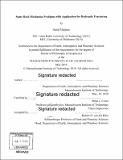Some rock mechanics problems with application for hydraulic fracturing
Author(s)
Mighani, Saied,1989-
Download1119388726-MIT.pdf (29.27Mb)
Other Contributors
Massachusetts Institute of Technology. Department of Earth, Atmospheric, and Planetary Sciences.
Advisor
Brian J. Evans.
Terms of use
Metadata
Show full item recordAbstract
Hydraulic fracturing is an essential tool used to enhance connectivity in shale gas reservoirs by maximizing the intersection between the hydraulic fracture (HF) and pre-existing natural fractures (NF) or faults. The technique is most effective when the hydraulic fracture crosses natural fractures rather than arresting on them. Experiments conducted to examine the interaction between HF and artificial pre-existing faults suggest that the coupling of diffusivity and fault slip is an important element of the HF-fault interaction problem. Fault slip, once activated is associated with an apparent increase in diffusivity. Whether the hydrofracture crosses or arrests on the pre-existing fault is also affected by surface roughness, differential stresses, and fault slip mode (i.e., stable or stick-slip sliding). Calibrated piezoelectric transducers were used to measure acoustic emissions (AE) generated during HF and fault slip. Moment tensor analysis of these events was used to distinguish pure tensile, shear, and possibly closure events during the experiments. Seismic moment magnitudes were approximately -7 for events during the initiation of the HF and about -5 for events during fault slip. Such a low ratio of seismic moments for tensile and slip events may explain the small numbers of tensile events recorded during reservoir stimulations. I also studied the time-dependent behavior in shales to gain insight into the post-stimulation efficiency of exploitations. Shale experiences strain hardening and compaction during loading by both isostatic (pressure-driven) and differential stress (shear-driven). Transient creep strain increased linearly with log(time), possibly transitioning to constant rate in timescale of several days. Motivated by the multi-scale nature of heterogeneities in shales, I examined the micromechanics of deformation using the nano-indentation technique. Elastic and creep moduli found in nano-indentation and triaxial tests agreed within a factor of 2, but within that factor, the creep strength may depend on spatial scale.
Description
Thesis: Ph. D. in Geophysics, Massachusetts Institute of Technology, Department of Earth, Atmospheric, and Planetary Sciences, 2019 Cataloged from PDF version of thesis. Includes bibliographical references (pages 185-205).
Date issued
2019Department
Massachusetts Institute of Technology. Department of Earth, Atmospheric, and Planetary SciencesPublisher
Massachusetts Institute of Technology
Keywords
Earth, Atmospheric, and Planetary Sciences.